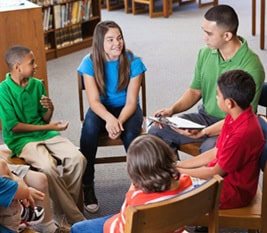Try These 5 Great Social Skills Activities for Students & Groups

|
Getting your Trinity Audio player ready...
|
Working as a school psychologist in the public school system for many years, I sometimes heard school counselors asking for advice about which social skills activities they should do with their students
Children in the group often had difficulty with skills such as:
- listening
- waiting their turn in conversation
- staying on topic
- sharing materials
- understanding another person’s feelings
- getting along with others
- resolving conflict
- appropriately expressing their own feelings
This article gives five suggestions for social skills activities for students and groups.
You may think these activities are more appropriate for elementary-age students but I think they can really be adapted for younger and older groups.
Activities can also be modified for a one-on-one situation such as parent/child or counselor/student.
What the research says about social skills instruction: Phillip C. Kendall, Professor of Psychology, reported the positive effects of using modeling and role playing, and teaching self-evaluation when teaching social skills.
Further research, such as Social Skills Training for Teaching Replacement Behaviors: Remediating Acquisition Deficits in At-Risk Students, confirms the benefits of intense social skills instruction.
5 Great Social Skills Activities for Students
1. Use engaging conversation, demonstration, role-play and/or visuals to teach students what social skills are and why we need to use them.
See an example of social skills below:

When first introducing kids to a social skills group it is a good idea to have them understand what social skills are and why they are important.
As a starting activity, write down different social skills (such as the ones from the list above) on individual slips of paper and put them in a bowl, hat, etc.
Have your students sit in a circle and pass around the slips of paper, taking turns pulling them out of the bowl one at a time.
When the student pulls the slip of paper from the bowl, ask them to say what the social skill means, have them give an example, and/or ask them to tell the rest of the group why that skill is important.
Give as much guidance and support as your students need to answer the questions. You may want to go first, to show the students how to do this activity.
Here is an example:
If a student picked “sharing materials” she could say “That means to let someone use something that you are using.
For example, if I am coloring with crayons I can let my friend borrow my crayons and color with me. Sharing is important because it shows others that you care about how they feel. Part of being a good friend is sharing.”
You could even have students act out the skills. So in this example, you can have one of your students pick materials to share with the other members of the group.
You can also let students create their own drawings of the skill you are talking about. To give you an idea of what I mean, below is a drawing of sharing:

Depending on the students’ skill and age level, frustration tolerance, and ability to sustain attention, you can do all of the suggestions I mentioned in this activity or just one.
You can break this into several lessons by only doing a few social skills at a time.
You also might want to add some skills that are not on the list such as showing empathy, staying on topic in conversation, and using manners.
Recommended Article: 15 Behavior Strategies for Children on the Autism Spectrum
2. Use games and fun activities to practice sharing, turn-taking, listening, following directions, encouraging others, and being polite.
In the video below, the therapist uses bubbles as the prop. Other objects can be used to tailor this activity to students of different ages.
Imagine implementing this same lesson but using activities such as shooting a basketball in a net, playing with a remote control car, doing an activity on the computer, etc.
Recommended Article: 8 Fun Activities to Practice Social Skills with Your Child
3. Use conversation starters to create a dialogue between students or between counselor and student.
Then the youth is supposed to ask another person a question related to the topic they pick, and the other person is to ask a related question back.
This activity allows students to practice listening, taking turns in conversation, staying on topic, and expressing interest in another person’s thoughts, ideas, and/or life. See examples in the video below.
The counselor in the video below encourages the students to pick a topic from a slip of paper in a cup (e.g., friendship, fears, favorite activities, etc..)
4. Teach what is means to be a friend.
This next video gives you great ideas for how to talk to children about what it means to be a friend.
After you show the video, have your students:
- tell you what they learned about being a friend
- draw a picture that shows someone being a friend to another person
- and/or practice one of the skills in the video
For example, this video mentions being a good listener and sharing as two of the things good friends do, so as part of the lesson have your students practice listening to each other and/or sharing items.
Talk to your students about what it means to be an active listener (e.g., looking in the direction of the person who is talking, waiting your turn to speak, responding to what the person said, trying to understand how the other person might be feeling, etc.).
The “What it means to be a friend” lesson could be a great segue into the lessons above which hone in on sharing skills and conversation skills.
Related Article: How to End Bullying Part 1: 19 Tips for Parents and Teachers
5. Practice complimenting each other.

Speaking of being a good friend, complimenting others (a great friendship skill) is another nice activity to do with your group.
Set the expectations from the beginning that only kind words and respect for each other is allowed in the group.
For this activity, you could go around in a circle and have each student say something nice about someone else in the group.
To make sure everyone gets a turn to be complimented, put people’s names on slips of paper in the bowl and have them pass it around taking turns pulling out names.
This activity will get easier as the students get to know each other better.
If the students just met and are not sure what to say about each other, allow them to say something nice about a family member or friend outside of the group.
As the group gets to know each other, the compliments should be about the group members.
Side Note: To teach self-evaluation, discuss how you and your student(s)/client(s) did during each activity. Give specific feedback about what went well and discuss areas that need improvement.
Let your clients share their own thoughts and perceptions about how they did during the activity. Encourage your clients to think about their own behavior when they are involved in similar real-life scenarios.
Education and Behavior – Keeping Us on the Same Page for Kids!
More Articles to Help with Social Skills
- 5 Great Activities to Do with Your Social Skills Group (Adolescents/Teens)
- Tips to Help a Child Not Be Alone at Recess or in the Cafeteria
- 5 Great Games to Play in a Social Skills Group
- 10 Great Books to Teach Social Skills to Children
- What Does Research Say About How We Can Teach Children to Have Empathy?
- 3 Research-Based Programs That Improve Social-Emotional Skills in School-Aged Children
- Engaging Social Studies Curriculum Shows Promise for Improving Social Skills in Students with Emotional and Behavioral Needs
- Interactive Book Helps Kids Understand the Power of Positive Choices!
- Theatre Teacher Shares Three Techniques to Increase Empathy in Students
- 5 Great Books to Teach Young Children About Empathy
- 9 Practical Strategies to Decrease Impulsive Behaviors in Children
- Roots of Empathy: A Research-Based Program that Counters Bullying
- 8 Fun Activities to Practice Social Skills with Your Child









